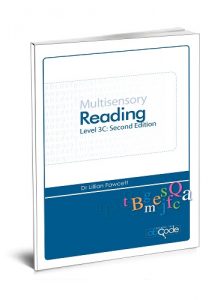
Which programs help improve reading?
For help in determining your child’s reading level go to: Start Here
To view the reading books Click Here
Click on the level for more information about each program
| READING AGE SCORED ON READING TEST | ||||||
| <6.02 years |
6.02- 6.06 years |
6.06- 7.00 years |
7.00- 8.00 years |
8.00-10.00 years | >10.00 years | |
| Doesn’t know alphabet |  |
|||||
| Knows alphabet not digraphs |  |
 |
||||
| Knows a few digraphs |
 |
 |
 |
 |
||
Note: 6.06 years refers to 6 years and 6 months.
The Theory: What makes a good reading intervention program?
First and foremost a good reading intervention program must be evidence-based. Today, this is commonly referred to as the ‘science of reading’.
Is phonics important?
Learning to read is a complex neurological task. The Cracking the ABC Code multisensory reading intervention programs are based on the premise that learning to read and spell requires a good understanding of how the sounds (phonemes) of the English language and represented in writing using different letters and combinations of letters (graphemes). This body of knowledge is called “Phonics” and research indicates that around a third of all students require specific instruction in this area in order to learn to read fluently and spell accurately. There is now substantial research showing that explicit teaching of phonics not only is an effective intervention strategy for struggling readers, especially for students with dyslexia (see for example Ryder, Tunmer and Greaney, 2008), but also results in structural changes to brain processing (see Shaywitz and Shaywitz, 2008). In the Cracking the ABC Code Multisensory Reading programs students are systematically introduced to graphemes (letters or combinations of letters) that represent each of the sounds (phonemes) in English. The graphemes are taught using a multisensory approach to maximise learning and includes the provision of key words and integrative pictures which serve as valuable memory cues.
What is syllabification?
Once students master decoding simple words, they need to be able to break a string of letters into manageable chunks and then combine the chunks into a meaningful word. The ability to quickly and accurately syllabify words is an important component of reading mastery and fluency. All the words in the vocabulary development section of the program are syllabified for the student according to how they are pronounced and each syllable is written in a different font to encourage students to attend to the letter sequence rather than the visual aspects of the word (a strategy recommended by Kilpatrick, 2019).
However, when it comes to decoding unknown words, the traditional rules for syllabifying words can be complex. The Cracking the ABC Code literacy programs teach students a simple strategy for breaking words into manageable chunks, thereby reducing the load on working memory. It is easily learned and can be effectively applied to the decoding of unknown words. This strategy is practised using nonsense and low frequency words and the effectiveness of this approach was demonstrated in Diliberto, Beattie, Flowers and Algozzine’s (2009) study.
How can you improve fluency & comprehension?
Schurz et al. (2010) found that reading is dual-route process whereby unknown words are first decoded (requiring good phonic knowledge), but then this information needs to be stored in long-term memory so that when the same letter string is encountered in future it is automatically recognised without having to decode the word again. In other words, reading is more than just decoding units of sound. Competency in reading also requires the ability to quickly and accurately break a string of letters into meaningful syllables, to fluently read groups of words as sentences and to accurately comprehend the meaning of that sentence and groups of sentences. The Cracking the ABC Code Multisensory Reading programs achieves this in several ways using a range of activities based on well researched memory and learning principles and strategies. For example, Vadasy and Sanders’ (2008) research and Lee and Yoon’s (2015) meta-analysis showed that timed and repeated reading exercises was an effective strategy for increasing fluency and comprehension. Poor reading rates and fluency is a common area of weakness for students with dyslexia. Consequently, this is one of the components incorporated into the Cracking the ABC Code programs.
Is multisensory learning effective?
Using multiple senses (sight, hearing and touch) means more areas of the brain are stimulated, resulting in the creation of more memory networks and consequently long-term learning. For example, in Krafnick et al.’s (2011) experimental study they found that dyslexia children who were taught using a multisensory approach not only made significant gains in their reading, but also showed an increase in neural connections. Given that poor working memory is often an area of weakness for students with dyslexia, the more strategies we can incorporate from the memory research, the more likely the student will be able to remember the information being taught. The Cracking the ABC Code multisensory reading intervention programs are systematic, logically structured and integrated in such a way that each aspect of a program reinforces and supports the other components. It has proven to be a highly successful program with students showing significant improvements in their reading skills in a relatively short time frame.
What pre-reading skills do children need?
Successfully learning to read requires the mastery of a range of pre-reading skills. These include developing good phonological awareness, having good visual processing skills and understanding the forms, functions and features of print. It also includes understanding that the written language is a code for the spoken language, that the function of print is to carry meaning, being able to differentiate between letters, words and sentences, and knowing the order and direction in which pages and print are read. Click here for a list of activities to help develop print referencing knowledge.
Five Steps for Encouraging Reluctant Readers to Read
References
Diliberto, J., Beattie, J., Flowers, C., & Algozzine, R. (2009). Effects of teaching syllable skills instruction on reading achievement in struggling middle school readers. Literacy Research and Instruction, 48, 14-28.
Kilpatrick, D. (2019). Equipped for reading success: A comprehensive, step-by-step program for developing phonemic awareness and fluent word recognition. Casey & Kirsch Publishers: New York.
Krafnick, A., Flowers, D., Napoliello, E & Eden, G. (2011). Gray matter volume changes following reading intervention in dyslexic children, Neuroimage, 57(3), 733-741.
Lee, J., & Yoon, S. (2015). The effects of repeated reading on reading fluency for students with reading disabilities; A meta-analysis. Journal of Learning Disability. 50 (2), 213 – 224.
Ryder , J., Tunmer, W., & Greaney, K. (2008) Explicit instruction in phonemic awareness and phonemically based decoding skills as an intervention strategy for struggling readers in whole language classrooms. Reading and Writing, 21 (4), 349-369.
Schurz, M., Sturm, D., Richlan, F., Kronbichler, M., Ladurner, G., & Wimmer, H. (2010). A dual-route perspective on brain activation in response to visual words: Evidence for a length by lexicality interaction in the visual word form area (VWFA) Neuroimage, 49(3), 2649–2661.
Shaywitz, S. E., & Shaywitz, B. A. (2008). Paying attention to reading: The neurobiology of reading and dyslexia. Development and Psychopathology, 20(4), 1329-49.
Vadasy, P., & Sanders, E. (2008). Benefits of repeated reading intervention for low-achieving fourth and fifth grade students, Remedial and Special Education, 29 (4) 235-250
Click on book image to purchase.









